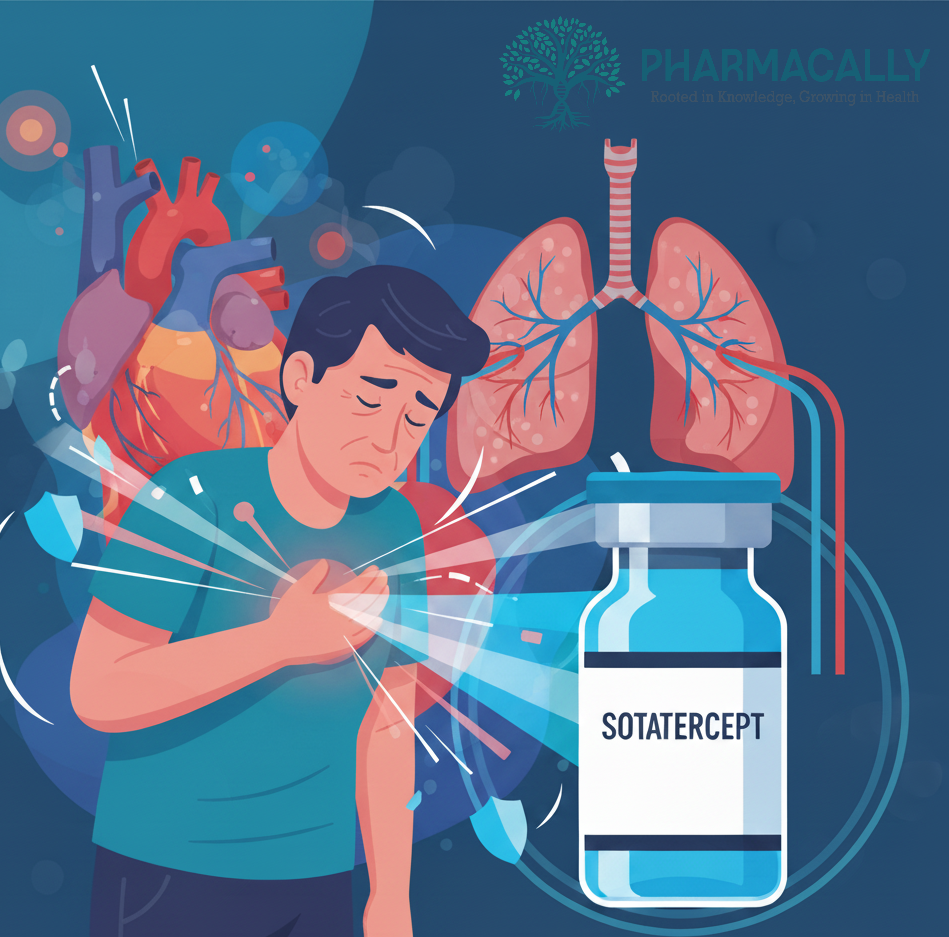Written By: Pharmacally Medical News Desk
A new study published in the New England Journal of Medicine shows that the early addition of sotatercept, an investigational activin-signaling inhibitor developed by Merck, can play an important role in altering the progression of pulmonary arterial hypertension (PAH). PAH is a rare condition that gets worse over time, putting pressure on the right side of the heart and often being diagnosed only after damage has begun. Traditional therapies seen to target pathways that relax the pulmonary vessels, but they do not fully address the abnormal cell growth and vascular remodeling that increase disease progression.
Sotatercept is an investigational fusion protein therapy that belongs to a class targeting the transforming growth factor-beta (TGF-β) superfamily. It is considered a novel therapeutic approach for pulmonary arterial hypertension (PAH).
Sotatercept works by restoring balance in TGF-β superfamily signaling, which is disrupted in PAH. In this condition, abnormal signaling promotes excessive growth and remodeling of the pulmonary blood vessels, increasing pressure in the lungs and straining the right side of the heart. Sotatercept binds certain ligands in this pathway, reducing pathological vessel growth and remodeling, which can improve blood flow, lower pulmonary pressures, and reduce the risk of disease worsening.
Previous large trials like STELLAR and ZENITH demonstrated that Sotatercept improved exercise capacity and reduced complications in patients with long-standing PAH. The new HYPERION trial builds on this evidence, showing for the first time that when Sotatercept is introduced within the first year after diagnosis, it significantly lowers the risk of clinical worsening events, even in patients already on modern combination therapies.
The HYPERION Trial
The phase 3 HYPERION trial (NCT04811092) enrolled 320 adults with WHO functional class II or III PAH diagnosed less than one year earlier. All participants were already receiving double or triple background therapy. Patients were randomly assigned to subcutaneous Sotatercept (loading dose, 0.3 mg per kg of body weight; escalated to target dose 0.7 mg per kg) every 21 days or placebo.
The primary endpoint was time to first clinical worsening event, a composite measure including death, hospitalization for PAH, need for lung transplantation, or significant decline in exercise capacity.
Key Findings
Clinical worsening occurred in only 10.6% of patients on Sotatercept group, on the other hand 36.9% on placebo group.
Declines in exercise capacity observed in 5% of patient as compared to 28.8% in placebo group and fewer unplanned hospitalizations was occurred in 3% of patient vs. 8.8% in placebo.
Death from any cause occurred in 7 patients, 6 patients contributing similar between groups at the time of analysis (4.4% vs. 3.8%).
Secondary endpoints, such as achieving a lower clinical risk score and multicomponent improvements in exercise tolerance and biomarkers, also favored Sotatercept.
The benefit appeared early after just three doses and was consistent across subgroups, including those with connective tissue disease–associated PAH.
Safety
Adverse events were common but generally manageable. The most frequent with Sotatercept were:
Epistaxis (31.9%)
Telangiectasia (26.2%)
Increases in hemoglobin levels and mild bleeding events
Serious bleeding occurred in a small minority (3.8%). Overall, the safety profile aligned with previous Sotatercept trials (STELLAR and ZENITH).
Clinical Implications
This is the first large study to show that starting Sotatercept within a year of PAH diagnosis reduces clinical worsening events, with a number needed to treat of just five patients over 12 months to prevent one worsening event. The results suggest a significant role for Sotatercept earlier in the disease course, though long-term safety and durability will need confirmation from the ongoing SOTERIA (NCT04796337) extension study.
Conclusion
The HYPERION trial shows that adding Sotatercept early to standard therapy can significantly slow disease progression in newly diagnosed PAH. Sotatercept cut the risk of clinical worsening events by about 76% compared with placebo. The drug does more than just relieve symptoms; it targets the disease progression itself. These benefits appeared even in patients already receiving two or three other PAH medicines, showing that Sotatercept could be an important early add-on treatment rather than a last option.
References
Vallerie V. McLaughlin, Marius M. Hoeper, David B. Badesch et al, Sotatercept for Pulmonary Arterial Hypertension within the First Year after Diagnosis, September 30, 2025, DOI: 10.1056/NEJMoa2508170
Study of Sotatercept in Newly Diagnosed Intermediate- and High-Risk PAH Participants (MK-7962-005/A011-13) (HYPERION), ClinicalTrials.gov ID NCT04811092, https://clinicaltrials.gov/study/NCT04811092?tab=history

